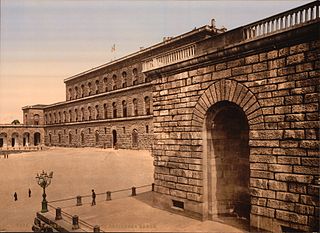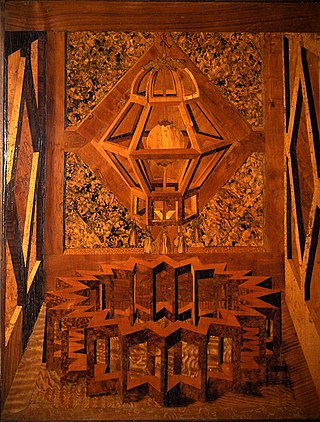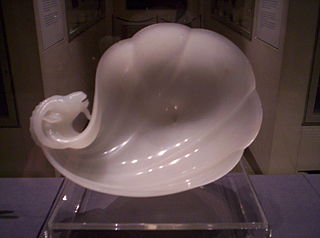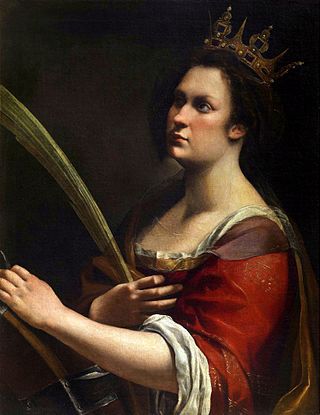
The National Palace Museum is a museum in Taipei, Taiwan. It has a permanent collection of nearly 700,000 pieces of Chinese artifacts and artworks, many of which were moved from the Palace Museum in the Forbidden City as well as five other institutions in mainland China during the ROC retreat. These collections had been transferred to several locations before finally being established in 1965 at its present location in Shilin, Taipei. The museum building itself was built between March 1964 and August 1965, with many subsequent expansions making it one of the largest of its type in the world, including a southern branch located in Taibao, Chiayi.

The Palazzo Pitti, in English sometimes called the Pitti Palace, is a vast, mainly Renaissance, palace in Florence, Italy. It is situated on the south side of the River Arno, a short distance from the Ponte Vecchio. The core of the present palazzo dates from 1458 and was originally the town residence of Luca Pitti, an ambitious Florentine banker.

Pietra dura or pietre dure, called parchin kari or parchinkari in the Indian Subcontinent, is a term for the inlay technique of using cut and fitted, highly polished colored stones to create images. It is considered a decorative art. The stonework, after the work is assembled loosely, is glued stone-by-stone to a substrate after having previously been "sliced and cut in different shape sections; and then assembled together so precisely that the contact between each section was practically invisible". Stability was achieved by grooving the undersides of the stones so that they interlocked, rather like a jigsaw puzzle, with everything held tautly in place by an encircling 'frame'. Many different colored stones, particularly marbles, were used, along with semiprecious, and even precious stones. It first appeared in Rome in the 16th century, reaching its full maturity in Florence. Pietra dura items are generally crafted on green, white or black marble base stones. Typically, the resulting panel is completely flat, but some examples where the image is in low relief were made, taking the work more into the area of hardstone carving.

Intarsia is a form of wood inlaying that is similar to marquetry. The start of the practice dates from before the seventh century AD. The technique of intarsia inlays sections of wood within the solid wood matrix of floors and walls or of tabletops and other furniture; by contrast marquetry assembles a pattern out of veneers glued upon the carcass. The word intarsia may derive from the Latin word interserere.

Kazan Cathedral or Kazanskiy Kafedralniy Sobor, also known as the Cathedral of Our Lady of Kazan, is a cathedral of the Russian Orthodox Church on the Nevsky Prospekt in Saint Petersburg. It is dedicated to Our Lady of Kazan, one of the most venerated icons in Russia.

Filippo Napoletano, whose real name was Filippo Teodoro di Liagno was an Italian artist, with a varied output, mainly landscape and genre scenes and also drawings or etchings of diverse, often particular, items such as exotic soldiers, skeletons of animals, or cityscapes.

The Gemma Claudia is a very finely carved and detailed, five-layered, cameo in sardonyx, a type of onyx that has parallel layers of sard which depicts members of the Roman imperial Julio-Claudian dynasty. It is believed to have been created in around 49 AD and by the 17th century was owned by the Habsburg Holy Roman Emperors, later passing to the Kunsthistorisches Museum in Vienna. It is 12 cm high and set in an 18th century gold circlet.

Capodimonte porcelain is porcelain created by the Capodimonte porcelain manufactory, which operated in Naples, Italy, between 1743 and 1759. Capodimonte is the most outstanding factory for early Italian porcelain, the Doccia porcelain of Florence being the other main Italian factory. Capodimonte is most famous for its moulded figurines.

Inlay covers a range of techniques in sculpture and the decorative arts for inserting pieces of contrasting, often colored materials into depressions in a base object to form ornament or pictures that normally are flush with the matrix. A great range of materials have been used both for the base or matrix and for the inlays inserted into it. Inlay is commonly used in the production of decorative furniture, where pieces of colored wood, precious metals or even diamonds are inserted into the surface of the carcass using various matrices including clear coats and varnishes. Lutherie inlays are frequently used as decoration and marking on musical instruments, particularly the smaller strings.
The Opificio delle pietre dure, literally meaning "Workshop of semi-precious stones", is a public institute of the Italian Ministry for Cultural Heritage based in Florence. It is a global leader in the field of art restoration and provides teaching as one of two Italian state conservation schools. The institute maintains also a specialist library and archive of conservation and a museum displaying historic examples of pietre dure inlaid semi-precious stones artefacts. A scientific laboratory conducts research and diagnostics and provides a preventive conservation service.

Certosina is a decorative art technique of inlaying used widely in the Italian Renaissance period. Similar to marquetry, it uses small pieces of wood, bone, ivory, metal, or mother-of-pearl to create inlaid geometric patterns on a wood base. The term comes from Carthusian monasteries, probably the Certosa di Pavia, where the technique was used in ornamenting an altarpiece by the Embriachi workshop.

Hardstone carving, in art history and archaeology, is the artistic carving of semi-precious stones, such as jade, rock crystal, agate, onyx, jasper, serpentinite, or carnelian, and for objects made in this way. Normally the objects are small, and the category overlaps with both jewellery and sculpture. Hardstone carving is sometimes referred to by the Italian term pietre dure; however, pietra dura is the common term used for stone inlay work, which causes some confusion.

Hardstone is a non-scientific term, mostly encountered in the decorative arts or archaeology, that has a similar meaning to semi-precious stones, or gemstones. Very hard building stones, such as granite, are not included in the term in this sense, but only stones which are fairly hard and regarded as attractive – ones which could be used in jewellery. Hardstone carving is the three-dimensional carving for artistic purposes of semi-precious stones such as jade, agate, onyx, rock crystal, sard or carnelian, and a general term for an object made in this way. Two-dimensional inlay techniques for floors, furniture and walls include pietre dure, opus sectile, and medieval Cosmatesque work – these typically inlay hardstone pieces into a background of marble or some other building stone.

The Patriarchate Court is a listed historical building which was the seat of the Patriarchate of Karlovci between 1848 and 1920, in Sremski Karlovci, Serbia.

The Madonna of Palazzo Medici-Riccardi is a painting by the Italian Renaissance artist Filippo Lippi. It is housed in the Palazzo Medici-Riccardi of Florence, central Italy.

The Casino Mediceo di San Marco is a late-Renaissance or Mannerist style palace located on Via Cavour number 57 and via San Gallo in Florence, region of Tuscany, Italy.
The Kimbolton Cabinet is an ornate wooden cabinet on a stand, designed by Robert Adam and completed in 1775. It is in the collection of the Victoria and Albert Museum.

Giovanni Maria Riminaldi was an Italian Roman Catholic cardinal.

Saint Catherine of Alexandra is a painting by the Italian Baroque artist Artemisia Gentileschi. It is in the collection of the Uffizi, Florence. Gentileschi likely used the same cartoon or preparatory drawing to create both this painting and the Self-Portrait as Saint Catherine of Alexandria (1615–1617), now in the National Gallery, London.

Andrea Scacciati was an Italian painter in the Baroque style, known mostly for his flower paintings.


















